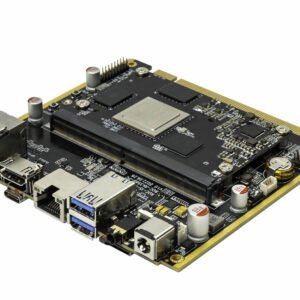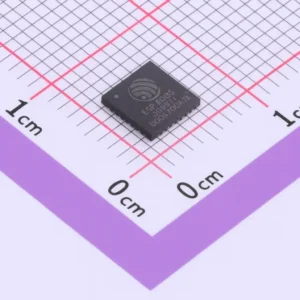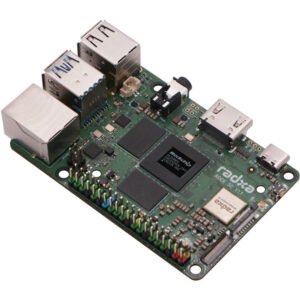RK3326 Rockchip RK3326 Quad-Core Cortex-A35 Processor – Full Specifications & Applications
-
Quad-core Cortex-A55 up to 2.0 GHz for responsive, power-efficient embedded compute.
-
1 TOPS NPU + Mali-G52 GPU for edge AI and modern graphics/compute APIs.
-
4Kp60 decode, 1080p60 encode, and multi-display support for rich media scenarios.
Rockchip RK3326 SoC Overview, Specifications, and Real-World Applications
The Rockchip RK3326 is a cost-efficient, low-power application processor built around a quad-core Arm® Cortex-A35 CPU running up to 1.5 GHz. Paired with a Mali-G31 class GPU and a dedicated 2D engine, it targets compact consumer and embedded devices that need responsive UI, smooth 2D/3D graphics, and robust video capabilities without the thermal or cost burden of larger SoCs. According to the vendor’s product page, the RK3326 was introduced in 2018 and remains a popular choice for handhelds and portable retro-gaming consoles thanks to its performance-per-watt profile and broad codec support.
At the heart of the multimedia pipeline, the chip handles multi-format 1080p@60fps video decoding (H.265/HEVC, H.264/AVC, VC-1, MPEG-1/2/4, VP8) and 1080p video encoding (H.264 and VP8). The display subsystem drives panels over RGB, LVDS, or MIPI-DSI up to 1920×1080 resolution, while the camera pipeline supports MIPI-CSI and DVP sensors and integrates a built-in 8-megapixel ISP for image signal processing. For memory, the device supports a wide spread of DRAM options—DDR4, DDR3/DDR3L, LPDDR2/LPDDR3—with 32-bit interfaces at listed data rates up to 1600. Non-volatile storage interfaces include MLC NAND, eMMC 4.51, and serial NOR flash, enabling cost-optimized or performance-oriented designs.
I/O is equally practical on compact boards: SDIO 3.0 for Wi-Fi/BT modules, USB 2.0 OTG for peripherals, and the usual embedded busses—I²C, UART, SPI—plus audio interfaces I²S/TDM and PDM with multi-channel support (1×8-ch I²S/TDM, 1×8-ch PDM, 2×2-ch I²S/PCM) for voice and audio products. These capabilities, together with the energy-efficient Cortex-A35 cores and small form factor packages, make RK3326 an accessible platform for handheld game consoles, smart displays, human–machine interfaces (HMI), point-of-sale devices, education tablets, and voice-enabled endpoints.
Key Specifications (Two-Column Table)
| Parameter | Value |
|---|---|
| CPU | Quad-Core Arm Cortex-A35, up to 1.5 GHz |
| GPU | Mali-G31 (G31/G31MP2 as referenced), OpenGL ES 3.2, Vulkan 1.0, OpenCL 2.0; dedicated 2D engine |
| Video Decode | Multi-format 1080p@60fps: H.265, H.264, VC-1, MPEG-1/2/4, VP8 |
| Video Encode | 1080p: H.264 and VP8 |
| Display Interfaces | RGB / LVDS / MIPI-DSI, up to 1920×1080 |
| Memory (DRAM) | 32-bit DDR4-1600 / DDR3-1600 / DDR3L-1600 / LPDDR3-1600 / LPDDR2-1066 |
| Storage | MLC NAND, eMMC 4.51, Serial NOR Flash |
| Camera | MIPI-CSI, DVP sensor interfaces; built-in 8MP ISP |
| Audio | 1×8-ch I²S/TDM, 1×8-ch PDM, 2×2-ch I²S/PCM |
| Connectivity I/O | SDIO 3.0, USB 2.0 OTG, I²C, UART, SPI |
| Launch Window | Introduced 2018 (vendor page note) |
Notes: The vendor page mentions both “Mali-G31 GPU” and “Mali-G31MP2” across sections; specific core count may vary by SKU/marketing text. Always validate with your module/board supplier.
Detailed Description
Efficient CPU complex. The Cortex-A35 architecture is a modern, power-sipping Armv8-A core that brings 64-bit readiness and better IPC than legacy A7/A5, while maintaining a tight thermal envelope. At up to 1.5 GHz across four cores, RK3326 delivers smooth UI interactions, multitasking for lightweight Linux or Android builds, and respectable emulation performance in handheld consoles—one reason the chip shows up so often in portable retro-gaming communities. Rockchips.net
Graphics and UI. The Mali-G31 GPU supports OpenGL ES 3.2, Vulkan 1.0, and OpenCL 2.0, which means your UI layer (Qt, Flutter, Android UI, LVGL with GPU accel paths) can take advantage of modern shader features within an efficient microarchitecture. A dedicated 2D engine offloads composition and scaling—useful for kiosk signage, HMIs, and OSD overlays—ensuring that the CPU remains available for application logic.
Multimedia pipeline tuned for 1080p. Hardware decode up to 1080p60 across mainstream codecs (H.265, H.264, VC-1, MPEG1/2/4, VP8) lets RK3326 render web streams, stored media, or camera feeds with low CPU overhead. On the encoder side, 1080p H.264/VP8 is ideal for live-view recorders, teaching aids, or low-bitrate streaming from smart cameras and handheld devices. The integrated JPEG encode/decode support (noted on the vendor page) is handy for still image workflows, thumbnails, and rapid UI asset handling.
Flexible displays and cameras. Whether you’re building a 7–10″ 1080p HMI, a compact LVDS industrial display, or a MIPI-DSI smartphone-style panel, the RK3326 display controller and interfaces accommodate common timing and resolutions up to 1920×1080. On the input side, MIPI-CSI and DVP connect to a wide range of sensors; the 8-megapixel ISP means you can integrate basic image processing (AE, AWB, noise reduction) on-chip without external ISPs, reducing BOM cost and power.
Memory and storage choice = cost control. Design teams can pick DDR4 for bandwidth, DDR3/DDR3L for commodity pricing, or LPDDR2/LPDDR3 for power-optimized handhelds. Storage spans eMMC 4.51 for OS/apps, MLC NAND for cost-sensitive products, or Serial NOR when a minimal footprint is needed. This breadth of options lets you dial the platform to your bill-of-materials targets while meeting performance goals.
Embedded I/O for connected products. SDIO 3.0 provides a straightforward path to Wi-Fi/BT combo modules. USB 2.0 OTG supports gadgets and accessories (cameras, MIDI devices, debug access). Multiple I²C/UART/SPI ports interface with sensors, touch controllers, GNSS modules, and secure elements. For audio, the I²S/TDM/PDM mix enables microphone arrays, stereo DACs/amps, and voice trigger systems using off-the-shelf codecs and digital mics.
Mature ecosystem. Because RK3326 has been in market since 2018, developers benefit from a sizable ecosystem of SBCs, SOMs, handheld reference designs, community builds, and BSP support. This maturity translates into faster prototyping, ready-made enclosures and accessories, and predictable supply chains—particularly important for long-tail industrial and education deployments.
Applications
-
Handheld gaming & retro consoles: Quad-A35 at 1.5 GHz plus Mali-G31 and 1080p codec support strike an excellent balance for emulators and classic-style titles while maintaining long battery life.
-
Smart displays & HMIs: LVDS/MIPI-DSI/RGB outputs to full-HD panels, with a 2D engine for snappy interfaces and an ISP for camera-assisted UI or vision add-ons.
-
Education tablets & e-learning devices: Efficient CPU/GPU combo handles web content, lightweight apps, and video playback/recording at 1080p.
-
Point-of-sale and kiosks: Multi-codec decode for ads and tutorials; secure peripherals over I²C/SPI/UART; Wi-Fi via SDIO.
-
Voice-enabled products: PDM and I²S/TDM interfaces support mic arrays and beamforming front ends for assistants or intercoms.
-
Entry camera systems: MIPI-CSI/DVP sensor inputs with 8MP ISP and 1080p H.264/VP8 encoding for local recording or streaming.
Three Small but Notable Highlights
-
1080p@60 decode across many codecs—broad compatibility for content and signage with minimal CPU load.
-
Built-in 8MP ISP—simplifies camera designs, cuts BOM by removing the need for a discrete ISP in many cases.
-
Wide DRAM choices (DDR4 → LPDDR2)—lets you optimize for either cost, power, or bandwidth without changing platforms.
Why Choose RK3326 for Your Next Design?
-
Balanced performance per watt: Cortex-A35 cores keep thermals in check; ideal for fanless handhelds and embedded enclosures.
-
Graphics that match embedded UI needs: Mali-G31 with OpenGL ES 3.2/Vulkan 1.0 covers modern UI frameworks and modest 3D.
-
Proven in the field since 2018: Mature BSPs, community knowledge, and readily available modules shorten your time to market.
Integration Tips (Brief)
-
Memory selection: For handhelds, consider LPDDR3 to balance bandwidth and power. For signage/HMI with heavier textures, DDR4-1600 provides headroom.
-
Wireless add-on: Pair SDIO 3.0 Wi-Fi/BT modules to avoid USB bus contention and to simplify power management.
-
Display tuning: Use the dedicated 2D engine for composition/scaling in your UI stack to keep CPU usage low and animations smooth.
Specification: Rockchip RK3326 Quad-Core Cortex-A35 Processor – Full Specifications & Applications
|






